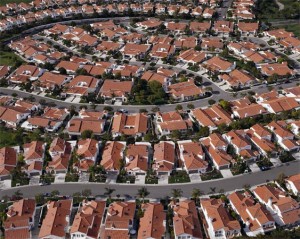Joel Kotkin and Wendell Cox recently tried to explain falling transit ridership in the Orange County Register, offering an inaccurate diagnosis of the cause, along with counter-productive, infeasible solutions.
First, the problem of falling transit ridership they describe is definitely real and pressing:
[S]ince 1990, transit’s work trip market share has dropped from 5.6 percent to 5.1 percent. MTA system ridership stands at least 15 percent below 1985 levels, when there was only bus service, and the population of Los Angeles County was about 20 percent lower. In some places, like Orange County, the fall has been even more precipitous, down 30 percent since 2008.
Yet they attribute falling ridership solely to the sprawling “urban form” of Southern California, which they argue is too spread out to support much transit, particularly rail. But this factor doesn’t necessarily explain why transit ridership is down nationwide. While researchers are still examining it, it is likely due to a combination of larger trends such as low gas prices, more congestion from increasing vehicle miles traveled (which slows down buses), higher fares and decreasing service, and the rise of venture capital-subsidized Uber and Lyft.
Still, Cox and Kotkin are right that Los Angeles is generally a “spread out” city, with the downtown area employing just two percent of the region’s workers (although it has pockets of density to rival any eastern city, such as the Wilshire Corridor). As a result, transit — particularly rail — has a tougher time attracting sufficient riders in low-density areas. This decentralized pattern has also been the cause of the region’s severe traffic (and air quality) problems.
But then Kotkin and Cox — pardon the expression — go off the rails. In their view, Los Angeles’ sprawling urban form is the result of collective individual preferences, as expressed in a free market for housing — and not public policy interventions. They see the single-family home with a two-car garage and a driving commute as the dream that virtually every American wants to achieve.
According to this logic, any effort that makes it harder to live in suburban-type housing must be a form of social engineering by heavy-handed government officials or greedy developers, trampling the will of the home buyer. They use expressions to characterize this dynamic like “a growing fixation among planners and developers” and “the urbanist fantasies of planners, politicians and developers.”
 And yet the evidence does not support their vision of the ideal housing situation. Land use is in fact one of the most regulated sectors of the economy, not the perfect expression of free market demand. The lack of density in economically thriving parts of Los Angeles has little to do with people’s aversion to “stack-and-pack” housing, as Kotkin and Cox term it. It is instead largely the result of highly restrictive zoning practices that prevent new multifamily housing near transit and jobs from getting built.
And yet the evidence does not support their vision of the ideal housing situation. Land use is in fact one of the most regulated sectors of the economy, not the perfect expression of free market demand. The lack of density in economically thriving parts of Los Angeles has little to do with people’s aversion to “stack-and-pack” housing, as Kotkin and Cox term it. It is instead largely the result of highly restrictive zoning practices that prevent new multifamily housing near transit and jobs from getting built.
Similarly, the suburban homes in communities far from job centers, like in the Inland Empire, are made feasible by public policies that subsidize the automobile and its related infrastructure. Basically, most home buyers have little choice: if you’re raising a young family, you’re likely priced out of expensive, job-rich neighborhoods due to the lack of new housing supply there. And you’re unlikely to want to live in high-crime urban areas with underperforming schools. As a result, your only option is cheap land in a far-flung suburban area.
Now to be sure, a sizeable percentage of home-buyers do want to live in suburban-style homes, but there are limits to that demand. In survey after survey, consumers report their strong preference for walkable neighborhoods and housing in proximity to jobs and schools. For example, a 2015 survey showed that 68% of Bay Area residents place a high or top priority on walkability for a home, while 50% want convenient access to transit from their home.
Furthermore, demographics run against the trend of suburbanization that Kotkin and Cox favor. Between 1970 and 2012, the share of households with married couples with children under 18 decreased by half, from 40 percent to 20 percent. Over that same period, the average number of people per household also declined from 3.1 to 2.6. To put it simply, these are not trends that argue for building more single-family, far-flung homes.
In short, Kotkin and Cox miss the policy support for decentralization and sprawl that contributes to the transit ridership problem. To reverse these negative ridership trends, policy makers should instead be lifting the barriers to new housing and commercial development near transit. They should also provide equitable funding for non-automobile infrastructure, such as bike lanes, pedestrian walkways, and transit. And they should price the externalities created by long-distance car commutes, such as through gas taxes that pay for the pollution and congestion pricing on crowded freeways and arterials.
But Kotkin and Cox instead advocate for unworkable solutions to address the ridership and mobility challenges. Specifically, they want more people to work from home, more Ubers and Lyfts, and a Hail Mary from autonomous vehicles to shuttle everyone around in robot cars.
First, working from home is not a viable long-term solution for many workers, given that only a certain percentage of jobs allow for this kind of arrangement, specifically office workers. Second, relying on Ubers and Lyfts, as well as autonomous vehicles, will only increase overall vehicle miles traveled in the region. This means more traffic overall, more lost open space, and more air pollution — all counter-productive results. And even if autonomous vehicles temporarily speed up freeway traffic, history has shown us time and again that increased road capacity only induces more car travel to fill it.
While Kotkin and Cox decry the worsening congestion from more “densification,” more compact neighborhoods actually decrease overall driving miles, even if congestion might worsen in the immediate areas. Along with sensible local parking policies, congestion pricing, and enhanced investments in transit, biking, and pedestrian infrastructure, the real solution is to create viable, compact neighborhoods close to jobs and transit, without forcing residents to be car dependent.
More of these transit-friendly communities would meet market demand and provide an alternatives for the growing demographic that is sick of business-as-usual housing options. It would also boost ridership on our buses and trains. But more of the status quo, as Kotkin and Cox propose, simply doubles down on failed policies that created the region’s mobility, economic, and quality-of-life problems in the first place.
One thought on “Kotkin & Cox Blast L.A. Rail For Failing To Support Their Suburban Utopia”
-
Pingback: Today’s Headlines – Streetsblog California
Comments are closed.



